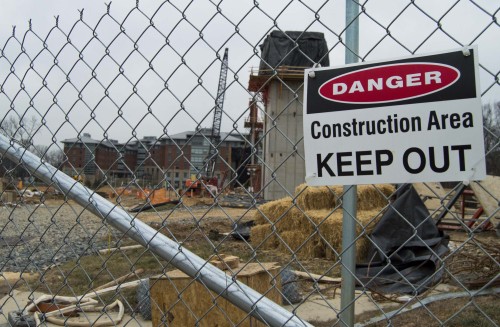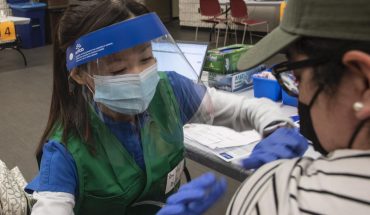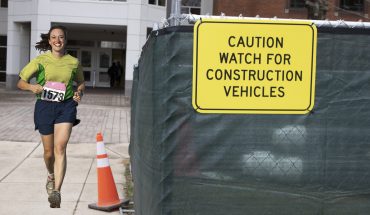This story was originally published in the Feb. 1 issue of Fourth Estate.
Prospects, promises and progress within the College of Health and Human Services

A new building for the College of Health and Human Services has taken the place of Lot H. Construction is expected to finish in August 2017. (Alya Nowilaty/Fourth Estate)
Members of the Mason community have likely noticed the large pile of dust and rubble lying next to Merten Hall. Most commuters know it as the construction site that consumed what was once Lot H.
It is, in fact, the site of Academic VII/Research III — a soon-to-be glamorous addition to the College of Health and Human Services (CHHS) and the product of a $71 million investment. Construction began in June 2015 and is expected to be completed in August 2017.
CHHS will undergo a metamorphosis in the coming years, both aesthetically, as stated in Academic VII, and internally, as the college pursues the addition of two academic departments: the School of Public Health (SPH) and the Community Health Institute (CHI).
Frank Whittington, associate dean of CHHS, said via email that this new building is designed to serve as the first “home” for CHHS and will finally “unite” the location of all academic departments and research centers as well as bring together faculty and staff.
The new building will include computer labs, a nutrition lab and kitchen, rehabilitation science labs and extra research space — all of which will be equipped with new technologies.
Statements released on the CHHS website outlined future ambitions and developments in CHHS, including a focus on the significance of the addition of the SPH.
The school will be Virginia’s first school of public health and will merge with CHHS to become the College of Public Health and Human Services.
The SPH will absorb the current department of global and community health, which will in turn house two new degree programs — epidemiology and environmental health. These programs will become part of the department within the next five years.
Robert Weiler, chair of the department of global and community health, said via email the greatest challenge in developing the SPH will be “obtaining the resources needed to hire the faculty and staff to launch the School of Public Health” as well as “dedicating the time and effort required to develop all the degree programs, have them approved by the state, and then preparing all the documents to meet the rigorous accreditation requirements.”
The departments of epidemiology and environmental health will include new doctoral programs in epidemiology and behavioral sciences. These additions will also create “joint graduate degree programs that combine public health with both nursing and social work,” according to the CHHS strategic plan. The aim of these new degree programs is to create “a stronger college that is capable of contributing multidisciplinary trained health practitioners and researchers able to meet the changing healthcare workforce needs of the region.”
Mason undergraduates within CHHS anticipate the completion of the building and simultaneous growth of the college.
“I think it [the new building] would be really cool because it’ll bring more exposure and attention to the community health major and also create better resources and specialties, because right now the concentrations are very narrow,” Brianna Santiago, a freshman community health and health administration double major, said. “And it’ll also give students more opportunities to find internships because there will be more faculty to contact.”
In addition to the SPH, the Community Health Institute will be housed in the completed Academic VII. The institute will have its own wing in the new building, which will function as a clinic for members of the Fairfax County community, as previously reported by Fourth Estate.
The CHI will also encompass a “multidisciplinary learning laboratory” for training nursing, nutrition, social work and rehabilitation science students, according to the CHHS website.
“For the first time, our faculty will not have to send all our students off campus to gain hands-on, clinical experience in an inter-professional environment,” Whittington said.
Alzahra Hamidaddin, a freshman community health major, said she is excited for the educational opportunities students will have through the institute.
“[The CHI is] an amazing opportunity for Mason students to be more hands on,” Hamidaddin said. “It also creates a balance of giving back to the community while also being able to learn from those who will come into the clinic.”
The addition of new health-related programs and physical expansion of CHHS may cause enrollment to grow considerably, according to the Strategy Website.
“[T]he construction of Academic VII/Research III as the College’s (CHHS) new home will become the very cornerstone of Mason’s plan and will create a powerful integrative force for the College,” Whittington said.
Additionally, Academic VII and the CHI will spur an enhancement of Mason’s “research capacity” due to the investment in “new faculty and laboratories which include … the Human Performance Laboratory for Rehabilitation Science, the Health Informatics Learning Laboratory in Health Administration and Policy, and the nutrition kitchen,” according to the strategic plan.
CHHS is also investing in the creation of a Dean’s Student Travel Fund, which will support a portion of the travel expenses for CHHS students, either graduate or undergraduate, who are presenting or co-presenting research papers at national conferences. The college also plans to increase the number of available awards and grants from two to 10 “for the purpose of expanding the number of students who can benefit from attending research conferences,” according to the strategic plan.
CHHS has also created the new faculty position Associate Dean for Community Engagement to direct and develop both educational (e.g., academic outreach) and service (community health clinics) opportunities for community residents, health and social service providers, and local governments.
“This position will be charged to increase communications both ways between our programs and the broad community as a necessary process for increasing community support of CHHS,” according to the strategic plan.
Gaby Marmelajos, a freshman majoring in health administration and policy, is enthused about the new building.
“It’s good because it’s going to make it easier for students to access administrators, faculty and professors, because right now you have to go to downtown Fairfax to the nutrition offices, or to the trailers in order to personally meet with faculty,” Marmelajos said. “This will make our faculty and staff a lot more accessible considering that the departments, which are far away, will all be housed in the new building.”
In related news, Mason’s health department has recently made headlines for announcing a partnership with Inova. Whittington said Academic VII could increase the benefits of this collaboration.
“Mason’s new formal partnership with Inova, coupled with our occupancy of the new building and the Community Health Institute, promise a major opportunity for expansion of the scope of our current activities and almost unlimited possibilities for innovation and improvement of both access and quality of health care in our region,” Whittington said.
Weiler also addressed the significance of the INOVA partnership.
“Establishing a School of Public Health … will complement initiatives across campus including the new partnership with Inova and the new community health clinic,” Weiler said.
The pile of dust and rubble may look a bit dismal now, but it seems to be in for a huge transformation. Whether or not the project will benefit the Mason community will be up to the execution of these ambitious endeavors.


